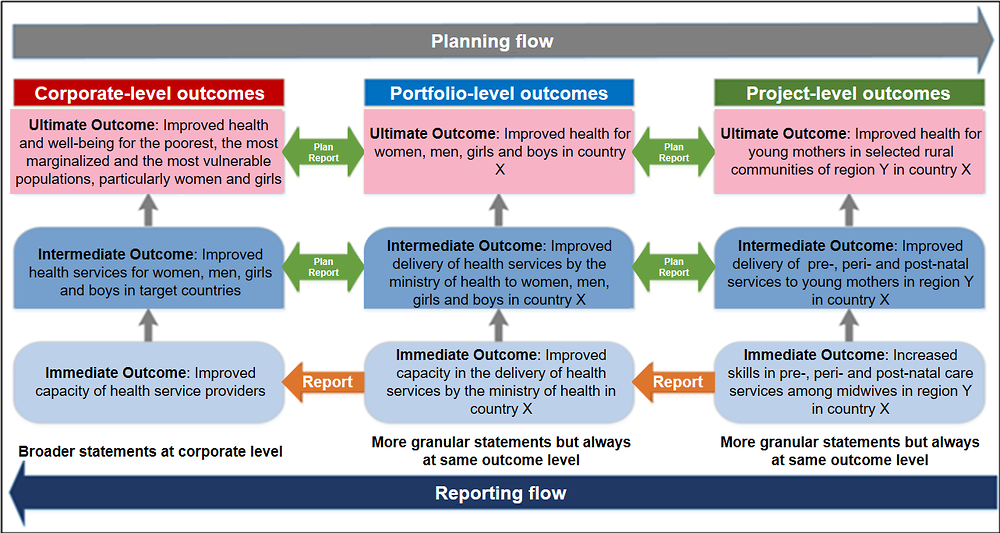Global Affairs Canada has developed the Architecture for Results of International Assistance (ARIA) approach to address ongoing issues in Managing for Results (MfR), such as lack of alignment among results frameworks, proliferation of indicators and lack of effective MfR at the corporate and portfolio levels. ARIA has already helped by providing a structural logic that links corporate, portfolio and project level outcomes and indicators. Work is underway for full implementation.
Global Affairs Canada’s architecture for results of international assistance

Abstract
Challenge
To inform strategic decision making, enable better Managing for Results (MfR) at the programme/portfolio and corporate levels, and report on the results of its efforts better, Global Affairs Canada (GAC) needed to find a way to address some of the following issues:
lack of alignment among corporate, programme/portfolio and project level outcomes and indicators
challenges with rolling up results information and indicator data (from about 1 500 projects), including multiple corporate-level expected outcomes and indicators
multiple corporate-level expected outcomes and indicators, making it challenging for staff to ensure effective alignment and roll-up of results information and indicator data
lack of a comprehensive methodology that guides staff on how results and indicators align at the planning stage and how results information can be rolled up for evidence-based assessment, decision making and reporting at the programme/portfolio and corporate levels.
Approach
GAC developed an Architecture for Results of International Assistance (ARIA) approach and methodology. It developed guidance, tools and training material to help staff implement this approach, which includes three guiding principles:
Distinguish policies from results frameworks. Results frameworks may need to change as we learn and adapt. Because policies are approved at high levels, they do not allow for this flexibility.
Use a manageable number of corporate expected outcomes and indicators.
Strengthen MfR at the programme/portfolio level to enable better strategic and operational planning, implementation and assessment than project management alone provides.
Outcomes at the programme/portfolio and project levels are more specific than at the corporate level in terms of “who experiences change”, “what change is experienced” and “where change takes place”. A horizontal nesting model is used to guide staff on the alignment of outcomes among the different levels.
Figure 1. The horizontal results nesting model: expected outcomes

Source: Global Affairs Canada.
A typology differentiates two types of indicators:
Commonly used indicators are standard indicators (e.g. Sustainable Development Goal indicators) identified for sectors or a theme in corporate-level results frameworks for use at the programme/portfolio and project level.
Consolidated indicators combine project-level indicators with others from the same “family” to form one broader indicator that allows for aggregation at the programme/portfolio and corporate levels. Consolidated indicators created by GAC are identified in corporate-level results frameworks for use at the programme/portfolio level. Family member indicators are used at the project level.
A classification of indicators distinguishes Complementary Performance Indicators (CPIs), which can be extracted from project to programme/portfolio level, and Key Performance Indicators (KPIs), which are aggregated from the project to the programme/portfolio level and then to the corporate level.
Results
The ARIA approach has allowed for better alignment at the corporate and portfolio levels among different results frameworks developed at different times, through different processes and responding to different requirements. This has helped to mitigate the number of indicators being used across these different frameworks and to provide clarity on how to align to these various frameworks at the operational level.
Eight Action Area Results Frameworks (AARF) have been developed to operationalise the priorities of Canada’s Feminist International Assistance Policy (FIAP) and its Action Area (AA) Policies into expected outcomes. In turn, the expected ultimate outcomes of these AARFs align to GAC’s broader Departmental Results Framework.
GAC has also deployed the approach to a number of its operations where the expected outcomes of country or thematic portfolios align horizontally to the expected outcomes of the AARFs, and thus to the priorities and path to action of the FIAP and AA Policies.
The horizontal nesting model has allowed programmes to tailor outcomes to varying programming contexts, while still aligning to relevant corporate-level outcomes and broad policy objectives.
The results frameworks share indicators where relevant, helping to mitigate the number of corporate indicators. Data collection on the FIAP KPIs is ongoing for the third year.
Lessons learnt
Implementation of the ARIA approach is successful when there is sufficient time to train and support staff. For example, GAC dedicated a team of MfR advisors to train all stakeholders when the eight AARFs were being developed. Nonetheless, challenges remain:
Frequent staff turnover in GAC makes knowledge transfer challenging on MfR and ARIA. Many new teams, including senior management, have not been made aware of the ARIA approach.
The ARIA approach may seem too technical for staff who do not have strong MfR knowledge.
GAC intends to do more to ensure better communication and capacity building and to implement the approach for the reporting stage.
Further information
GAC, Results-based Management Tip Sheet 2.1: Results Chain and Definitions, https://www.international.gc.ca/world-monde/funding-financement/rbm-gar/tip_sheet_2-1-fiche_conseil_2-1.aspx?lang=eng&_ga=2.29504639.1731054909.1618851075-1894906507.1608741376.
GAC, Architecture for Results of International Assistance Concept and Guidance: Enabling Managing for Results at the Portfolio and Corporate Level within Global Affairs Canada (Upcoming).
OECD resources
OECD, Results in development co-operation, https://www.oecd.org/dac/results-development.
OECD, Guiding Principles on Managing for Sustainable Development Results, https://www.oecd-ilibrary.org/development/managing-for-sustainable-development-results_44a288bc-en.
OECD, Provider Case Studies: Canada, Global Affairs Canada, https://www.oecd.org/dac/peer-reviews/results-case-study-canada.pdf.
To learn more about Canada’s development co-operation see:
OECD (2021), "Canada", in Development Co-operation Profiles, OECD Publishing, Paris, https://doi.org/10.1787/aa7e3298-en.
OECD (2018), OECD Development Co-operation Peer Reviews: Canada 2018, OECD Development Co-operation Peer Reviews, OECD Publishing, Paris, https://doi.org/10.1787/9789264303560-en.
Related content
-
 30 September 2024
30 September 2024 -
 Case study27 September 2024
Case study27 September 2024 -
 27 September 2024
27 September 2024 -
 16 September 2024
16 September 2024 -
 11 September 2024
11 September 2024 -
 10 September 2024
10 September 2024